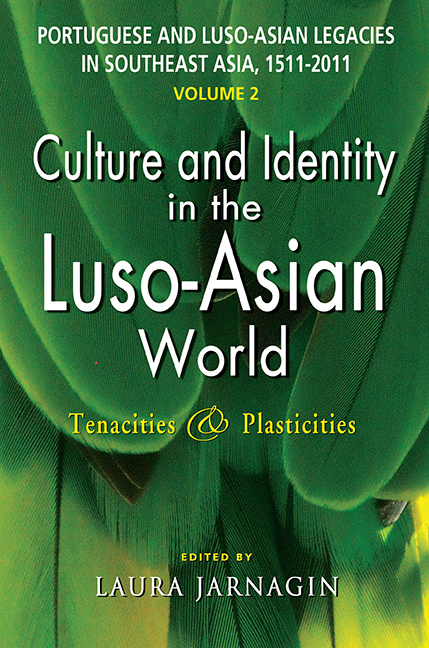 Portuguese and Luso-Asian Legacies in Southeast Asia, 1511-2011, vol. 2
Portuguese and Luso-Asian Legacies in Southeast Asia, 1511-2011, vol. 2 Book contents
- Frontmatter
- Contents
- List of Figures and Tables
- Preface
- List of Contributors
- Glossary
- Introduction: The Qualitative Properties of Cultures and Identities
- Part One Crafting Identity in the Luso-Asian World
- 1 Catholic Communities and Their Festivities under the Portuguese Padroado in Early Modern Southeast Asia
- 2 A “Snapshot” of a Portuguese Community in Southeast Asia: The Bandel of Siam, 1684–86
- 3 The Colonial Command of Ceremonial Language: Etiquette and Custom-Imitation in Nineteenth-Century East Timor
- 4 Remembering the Portuguese Presence in Timor and Its Contribution to the Making of Timor's National and Cultural Identity
- Part Two Cultural Components: Language, Architecture and Music
- Part Three Adversity and Accommodation
- Appendix: Maps
- Bibliography
- Index
- Titles in the Nalanda-Sriwijaya Studies Centre Series
1 - Catholic Communities and Their Festivities under the Portuguese Padroado in Early Modern Southeast Asia
from Part One - Crafting Identity in the Luso-Asian World
Published online by Cambridge University Press: 21 October 2015
- Frontmatter
- Contents
- List of Figures and Tables
- Preface
- List of Contributors
- Glossary
- Introduction: The Qualitative Properties of Cultures and Identities
- Part One Crafting Identity in the Luso-Asian World
- 1 Catholic Communities and Their Festivities under the Portuguese Padroado in Early Modern Southeast Asia
- 2 A “Snapshot” of a Portuguese Community in Southeast Asia: The Bandel of Siam, 1684–86
- 3 The Colonial Command of Ceremonial Language: Etiquette and Custom-Imitation in Nineteenth-Century East Timor
- 4 Remembering the Portuguese Presence in Timor and Its Contribution to the Making of Timor's National and Cultural Identity
- Part Two Cultural Components: Language, Architecture and Music
- Part Three Adversity and Accommodation
- Appendix: Maps
- Bibliography
- Index
- Titles in the Nalanda-Sriwijaya Studies Centre Series
Summary
The year 1618 was special for the Catholics of Cochinchina (now part of Vietnam). Portuguese Jesuits had established their mission in the country three years previously and this year another group had arrived to found a new church in the small, bustling trading town of Hôi An. The Jesuits brought news of an Extraordinary Jubilee: this would grant Catholics who heard it and met its conditions a plenary indulgence for themselves or their departed loved ones. Local Catholics were joined by visitors from out of town, and the assembled audience of Portuguese, Japanese, Chinese and Vietnamese Christians congregated at the new Jesuit church to hear its publication. So many people came that despite the large size of the church, the congregation filled the building and spilled into the street. Other religious festivals that year, Jesuit Francisco da Pina reported, were celebrated with noteworthy fervour. On each Friday of Lent, large numbers of Christians, especially those from the expanding Japanese quarter of the city, engaged in spiritual exercises, public and private penances, and other devotions, “stripping themselves and clothing themselves anew” — spiritually speaking — ready for Easter. This they celebrated together with “as much internal joy as external”. Christmas was greeted with similar communal celebrations, with even some “pagan Japanese” neighbours joining in “with their dances and songs”. The latter, we are told, were often inspired to convert to Catholicism in the process.
We can find similar accounts of communal devotions and public Catholic festivities scattered throughout early modern missionary accounts from Southeast Asia. This chapter uses descriptions of such events as the starting point to explore Portuguese and Asian Catholic identities and communities in three cosmopolitan Southeast Asian cities in the late sixteenth and seventeenth centuries: Hôi An (known as Faifo to Europeans), Malacca, and Ayutthaya in Siam (Thailand). In each city there was a Portuguese settlement and a number of non-Portuguese Catholic communities. In each locale, these varied communities developed religious devotions that suited the rhythms of their lives and their cultural heritage.
- Type
- Chapter
- Information
- Portuguese and Luso-Asian Legacies in Southeast Asia, 1511-2011, vol. 2Culture and Identity in the Luso-Asian World: Tenacities & Plasticities, pp. 21 - 43Publisher: ISEAS–Yusof Ishak InstitutePrint publication year: 2012


